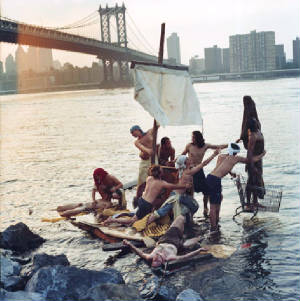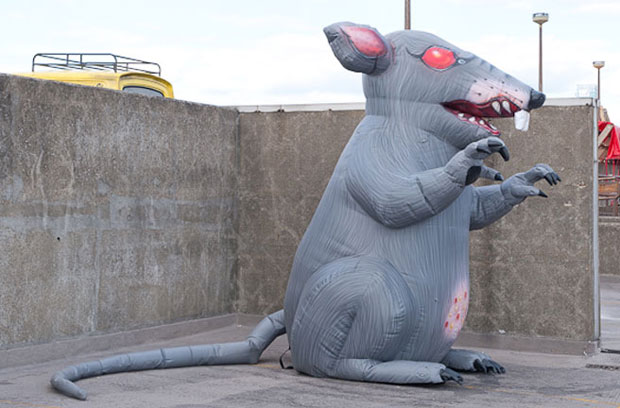|
Bruce High Quality Foundation, Trailer for Ode to Joy, Brooklyn
Museum, 2013.
The Madness to Come: My
Foray into the Bruce High Quality Foundation
By Harry J. Weil
“Nothing sorts
out memories from ordinary moments. Later on they do claim remembrance when they show their scars. That face he had seen was
to be the only peacetime image to survive the war. Had he really seen it? Or had he invented that tender moment to prop up
the madness to come?” Chris
Marker, from La Jetée
The narrator in Chris Marker’s
cult classic La Jetée suggests that memories, no matter how close and dear to us they may be, are masked by layers
of doubt. Things, people, and events that were once so familiar and real, can at any point feel distant and strange. Such
a sentiment figures well into the work of The Bruce High Quality Foundation (BHQF) who used Marker's words in a press release
for a 2008 exhibition at the Susan Inglett Gallery and whose objective is to “resurrect art history from the bowels
of despair, and to impregnate the institutions of art with the joy of man’s desiring.” Whether it is from the
market or the pervasive cult of personalities, BHQF tries to salvage what it can from the storehouses of museums and
the jargon of the academy. Filling their work with parody and absurdity, they speak of a generation coming of age in
the midst of economic recession, frustrated by the failure of post-modernism, yet resolved to drudge through a time
of uncertainty. I first came to know BHQF at the
Whitney’s 2010 Biennial with their installation We like America and America Likes Us, which consisted of a white
hearse, reportedly purchased off of Craigslist, altered so that the windshield became a projection screen. The film (played
on loop) was a hodgepodge of material sourced from popular culture running the gamut from movie clips (Pulp Fiction,
West Side Story and Dangerous Minds), viral YouTube videos, Barack Obama dancing on The Ellen DeGeneres Show,
and segments from the Fox News Network, amongst others. The title is a reference to Joseph Beuys’s performance I
like America and America Likes Me (1972), where he lived with a coyote for three days in an art gallery in New York City.
This performance is the stuff of legend, serially told and retold by way of surviving documentation and countless interpretations.
Yet, in their homage, BHQF turns its focus on how such stories permeate in our culture, how they grab our attention and become
so ingrained in our collective psyche, or as David Werner, writing for the The Huffington Post, explains, the flickering
of images, from one to the next, which mimics our everyday inundation with things (thanks to YouTube, and smart phones), is
symptomatic of our inability to make heads or tails of what we, both as individuals and as a nation, value. And when coupled
with celebrity driven culture and reality star icons, there unfolds a sadistic guilty pleasure, where the madness to come
is, in fact, the madness in which we are already entrenched.

The Bruce High Quality Foundation (American). Raft of the Medusa, 2004. Chromogenic print.
Private Collection.
It is a bit tricky to define BHQF. From
what I can surmise, they are a group of artists, mostly if not all graduates of the Cooper Union, working in tandem since
2004 and based in Brooklyn, New York. (However, in a recent interview with Vogue, they deny any such affiliation: “It’s
a filthy lie. We have no relationship with any school that thinks going into debt is a good way to learn to be an artist.
It’s just stupid.”) We can draw connections to other post-World War II art collectives, as others have, which
similarly sought out to challenge the established art world with grand utopic visions (think participatory art practices freed
from authorial control). However, it is important to give BHQF their just reward, not as copycats of some bygone artistic
tradition, but as heirs to a rich counter-culture tradition (for more on this, see Legacy Russell’s essay “A Fictive Retrospective of the Bruce High Quality Foundation”). This is apparent in Brucennial, a biennial exhibition started in 2010, claiming to be: “[t]he single most
important art exhibition in the history of the world. Ever.” Alongside the more established international exhibitions,
including the Whitney Biennial, Venice Biennale, and Documenta, BHQF’s curatorial methodology is less ideological than
it is nepotistic: “[E]ssentially an elaborate word of mouth process. When we first started putting the show on, we asked
our friends. And then they asked their friends. And now six years later, we have a lot of friends.” In 2009, they founded The Bruce High Quality Foundation University,
where “artists work together to manifest creative, productive, resistant, useless, and demanding interactions between
art and the world” with free lectures, workshops and studio courses. As an alternative to over-priced graduate programs
(according to their respective websites, tuition at the School of Visual Arts is $17,370 a semester, while at the Tisch School
of the Arts at New York University it is $49,237 a year), the unaccredited University allows students to explore their intellectual
curiosities in welcoming and accessible environments, while also breaking out of the cycle “of debt for education.”
This anti-institutional impulse is further evidenced in The Stag Glares Back (2011), a slopped together, rough-and-ready
classroom installation of chairs and desks, all made from sheetrock and held together with hot glue. If a gust of wind were
to blow through, the whole installation would fall apart and vanish in a cloud of dust. The selectivity that has foregrounded
the philosophies and ideologies of academicians and scholars, and those who support them, amounts to nothing more than the
makeshift ivory towers they have constricted for themselves – towers that limit access while protecting their inhabitants
from ridicule.

The Bruce High Quality Foundation, Apology, 2011. Inflatable Sculpture.
BHQF pushes all things, no matter how
serious or valued, to the point of comedic distortion. Take Con te Partiro, consisting of a used-looking janitor’s mop
and bucket that have be retrofitted with speakers playing Andrea Bocelli’s version of Con te Partiro. Listen
to the words (or, as I did, use Google translator): “Time to say goodbye to countries I never saw and shared with you,
now, yes, I shall experience them.” them.” Is BHQF leading us to believe in something unachievable, true love?
Star-crossed destiny? Dreaming impossible dreams? Their message, on the contrary, as others have duly noted, is a biting
metaphor of the smoke and mirrors museums and galleries employee to solicit audiences, and their cash. The work sat right
outside the doors to their recent retrospective at the Brooklyn Museum, Ode to Joy, and so to hear Bocelli's soothing
voice, you had to listen very intently amid the foot traffic of adjacent galleries. And the closer you got, the more you realized
that all you were doing was staring into a dirty mop bucket. For Ode To Joy, BHQF released a series of promotional videos
parodying big-screen theatrical trailers, each with the tag line “Featuring less than 17,000 works.” In a spin
on Thelma and Louise, they take the last minute of the film, where the two main characters are driving off the edge
of the Grand Canyon in a suicide pact, and set it to Flock of Sea Gulls’ I Ran (So Far Away). But we don't see
the faces of Susan Sarandon and Geena Davis, which are overlaid with cartoonish masks. In another, scenes from Alien of
astronauts frantically trying to battle space monsters accompany The Champs’ up-beat instrumental Tequila. While
humorous, if not entertaining to watch, they are none the less aggressive. I am reminded of Michael Biling, who, through a
reading of Freud, explains that aggressive thoughts, “which are forbidden in polite society, can be shared as if they
are not serious. Humor then becomes a way of rebelling against the demands of social order.” By channeling, and making
light of, movies that are so familiar to us (I am speaking directly about the United States here), BHQF is interested in how
the gestures, feelings, and emotions of these fictional scenarios are remembered and recalled when read in an altered context
(much the same as their take on Beuys).
This “reframing
of cultural discourse,” as labeled by the Brooklyn Museum on its website, is also evidenced in the myriad of art
historical references in their oeuvre, from Ancient Greek vases to Picasso’s Demoiselles d'Avignon. In
a restaging of Gericualt’s The Raft of the Medusa on the banks of the East River, a rag-tag group of hairless
boys in jean shorts mimics the Michalangelo-esque poses, with the Manhattan Bridge looming in the background. They mirror
each curve and bend of the body, with one standing proudly in a supermarket wagon holding a tattered white rag. Gericault
was protesting against the French political establishment, and his work came to be a lasting symbol of survival against the
forces of both man and nature. BHQF’s rendition is also about survival, but in a much different vein. Here, this broken,
but not defeated, motley crew of hipsters stands resolved to find their art world success. And in their makeshift raft, they
set sail once again, like so many others have, to fulfill their hopes and dreams. BHQF carefully walks a thin line here, as their work is edged betwixt and between the
art world it critiques, yet is still very much involved. While everything I have read about them has painted a portrait of
disgruntled art world kids getting their revenge, it is only after some time that I have come under their spell. What sealed
the deal was the realization, after seeing their exhibition, that my ideas of what art could be had become a tangled mess,
where any sense of reality or fiction was overtaken by feelings of suspicion and frustration. And so I laughed, often very
audibly, walking through the exhibition, much to the irritation of my friends: “What’s so funny?” they asked.
I didn't have an easy answer, and still don't think I do. But what I do know is that that in the face of any madness, humor
is the best course of action.
|
